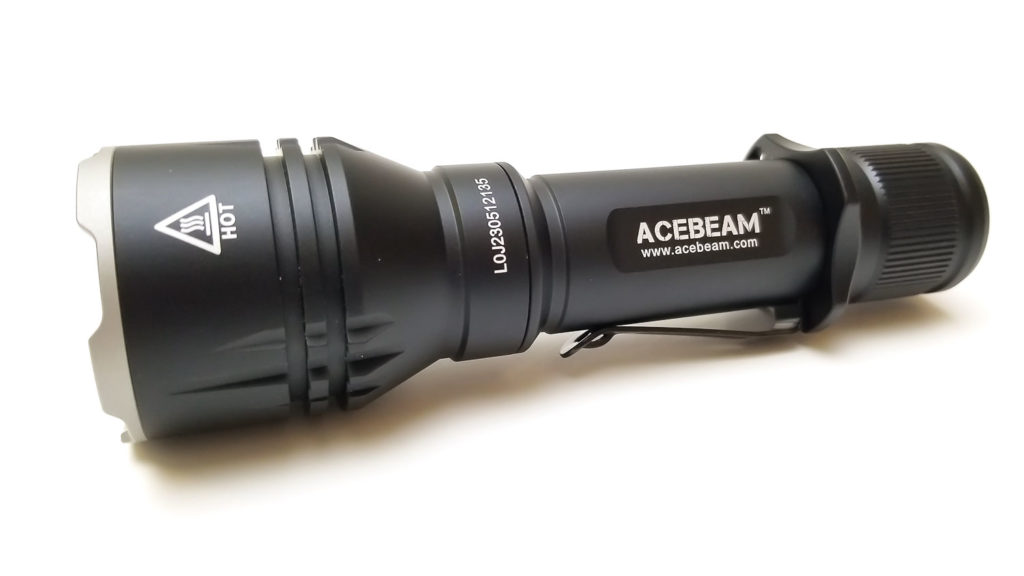Acebeam L17 review
Acebeam L17 specifications
| Brand / Model | Acebeam L17 |
|---|---|
| LED | OSRAM W2 White |
| Lumens | 1400 lm |
| Beam intensity | 160,801cd |
| Battery config. | 1*18650 / 2*CR123A |
| Material | Aluminum |
| Modes | 5 |
| Blinkies | Strobe |
| Reflector | TIR optic |
| Waterproof | IP68 |
| Review date | August 2020 |
Introduction:
Acebeam is a brand that needs little introduction for flashlight enthusiasts. Their product line spans small EDC lights, tactical lights, LEP throwers, and huge 60,000 Lumen monsters. When they introduced a new tactical light, I expected something innovative, and that’s what Acebeam delivered with the L17. What makes this light so interesting is Acebeam makes a pretty bold claim that this is the longest-throwing single 18650 tactical flashlight! How bold? They claim 160 kcd and 802 meters of throw. It does have some impressive features, but has Acebeam really created the longest-throwing tactical flashlight? This is my first hands-on with an Acebeam, and I’m a bit of a skeptic since flashlight manufacturers tend to exaggerate output figures. Who knows? Maybe I’ll be pleasantly surprised.
What you’ll get:
The Acebeam arrived in a very nice retail package (albeit a little beaten up from the post). It’s probably one of the nicest I’ve seen in a while. The outside of the box is really crowded with a lot of information including the product description, specifications, and other information. Overall a very nice package. Inside it’s equally crowded with a lot of accessories. No bare necessities with this kit as you get everything you could possibly need to get up and running, including the charging cable and a protected Acebeam 3100 mAh battery with integrated micro USB charging. On a side note, they didn’t cheap-out on the included accessories. Everything was really good quality.
- Acebeam L17
- 3100 mAh protected 18650 battery with integrated Micro USB charging
- 2 spare o-rings
- Spare tailcap boot
- 1 meter-long micro charging USB cable
- Nylon holster
- Lanyard
- Warranty card and lithium battery warning
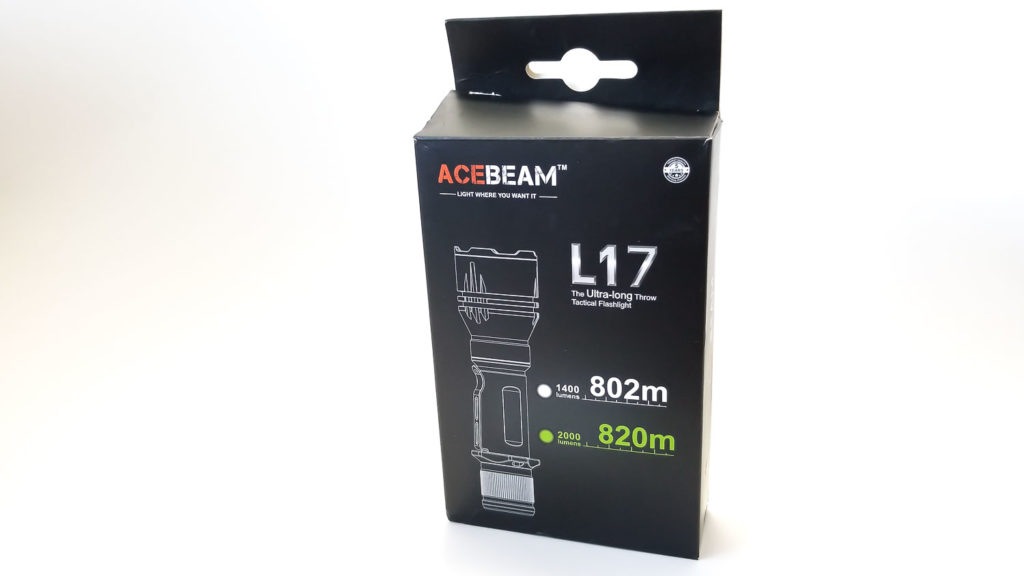
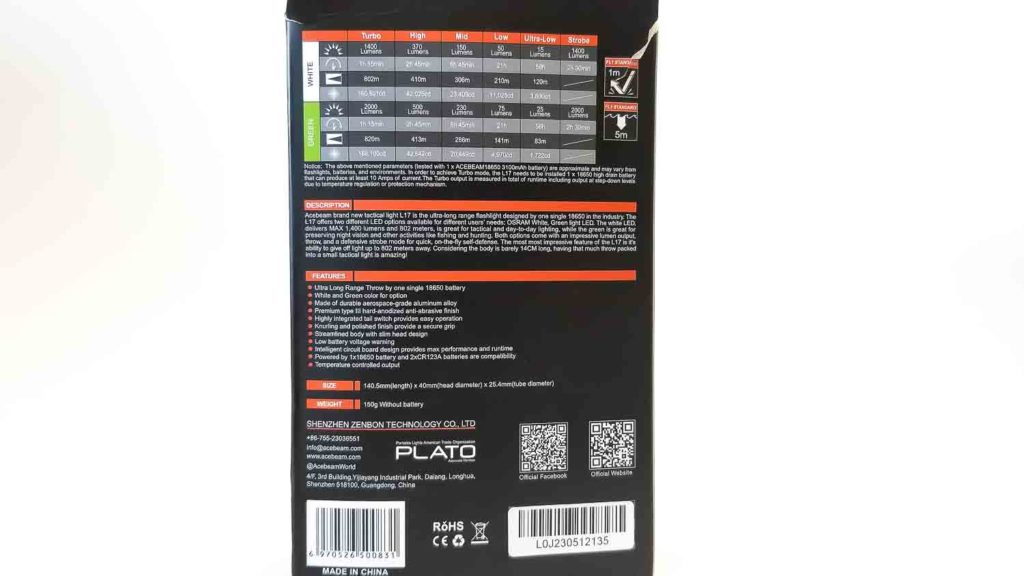
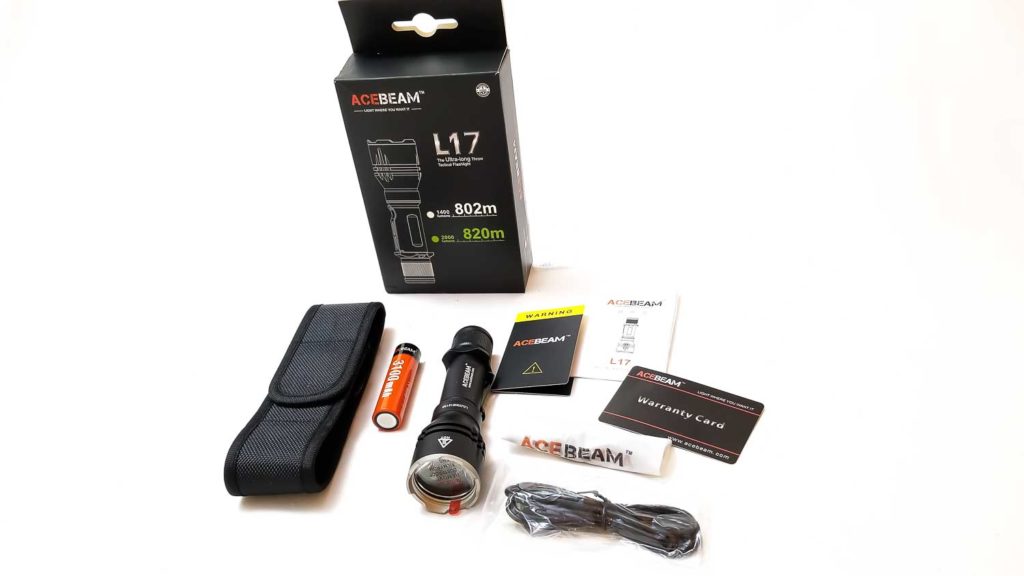
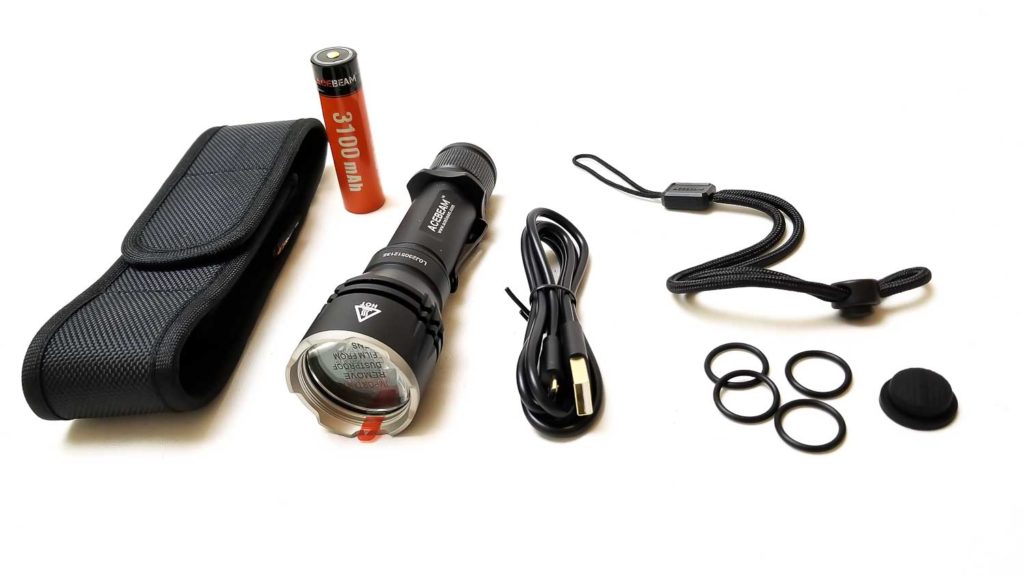
Handling of the light
Acebeam is reputed to make a nice flashlight and the L17 is no exception. The light is very nicely balanced in my hand. It’s about the same size as a C8 pattern light, but it’s a little shorter and the head is slightly smaller. The finish is excellent and more matte than glossy, which I prefer, and feels really great in my hands. Despite the fact there is no knurling anywhere on the light, I never felt like I was going to drop it.
It comes with an anti-roll ring which helps with a cigar grip. I didn’t have any trouble getting to the switch with the tip or pad of my thumb. Acebeam also offers an optional remote pressure pad switch that replaces the tailcap switch so you can mount it on a rifle or shotgun. The light has a blackened stainless pocket clip attached. It’s very sturdy and has excellent tension so it never felt like it was going to fall off of whatever I clipped it to. You can remove the anti-roll ring and the clip, but unfortunately, you can’t change the position of the clip since it’s indexed to a flat spot on the body and it won’t fully clip onto the battery tube if out of position.
Acebeam also includes a nice nylon holster with elastic sides, but it did hold the light a little too snugly, and it got hung up on the anti-roll ring when extracting it quickly. The belt clip on the back has a brass snap surrounded by Velcro. This is a nice detail because it will keep the snap from coming open even when jostled or shaken violently (like during a sprint or a fall), or if the snap wears out from use. There’s also a sturdy plastic ring on the backside for clipping the holster to a carabiner on a backpack or other attachment point.
I was happy to see the included lanyard is one of the nice ones with an adjustable cinch that lets you easily tighten or loosen it.
Now the switch was let down. Acebeam markets it as a “forward click tactical switch,” but that’s not accurate. A true forward switch turns the light on when you press it, and this allows momentary use, signaling, Morse code, etc. A reverse switch turns the light on after it’s fully clicked and released. The L17 has the latter, since the light turns on after you release the switch.
I couldn’t detect a definite click or audible feedback from the switch, and it just felt mushy and sloppy. Maybe the silent operation is intentional for stealth? I think Acebeam could have incorporated some sort of tactile feedback into it at the very least. I’m sure it’s a quality switch, but honestly I’ve felt better switches on the $5 flashlights I find at the thrift store.
Curiosity got the best of me and I took the switch apart to see if it was defective, but it seemed to be in order. The switch itself is surprisingly small (even smaller than an Omten 1288) and soldered to a PCB held into the tailcap by two tiny phillips screws. The switch PCB has a contact tab and contact ring. I suspect the tab interfaces with what looks like a separate liner in the body that creates a contact point for the driver’s memory function.
Yes, the flat tailcap and flush switch boot allow it to tail stand no problem.
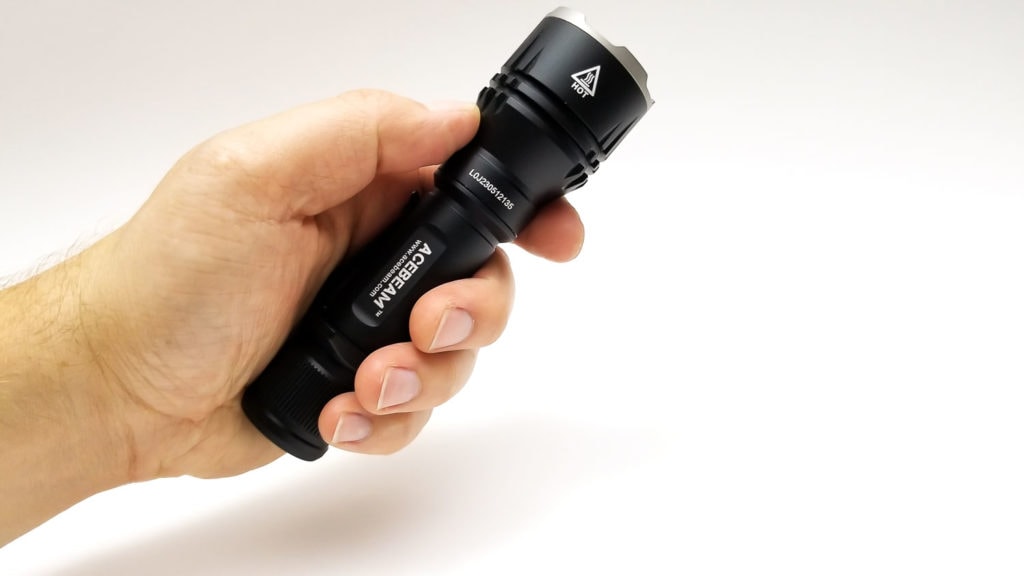
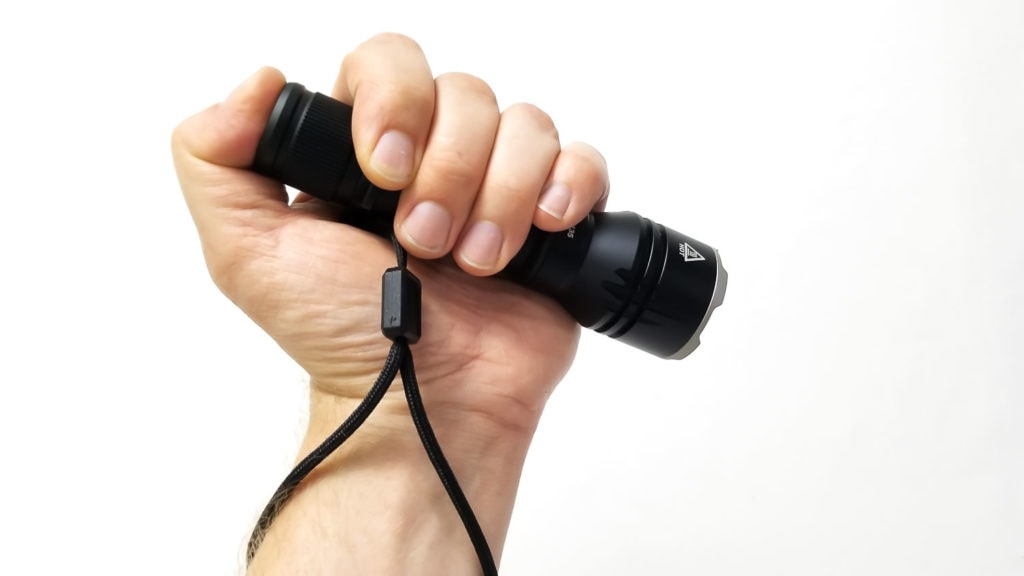
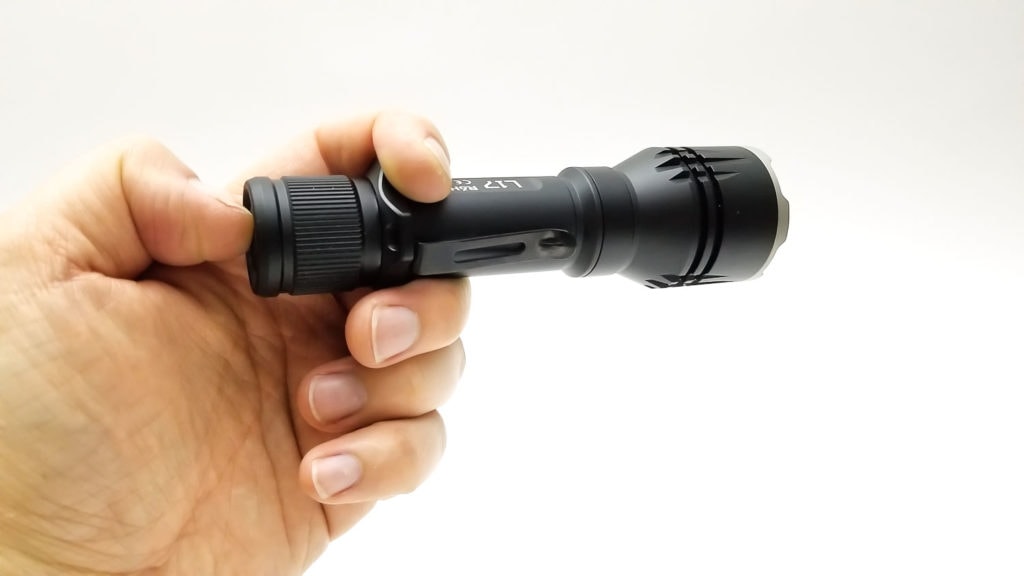
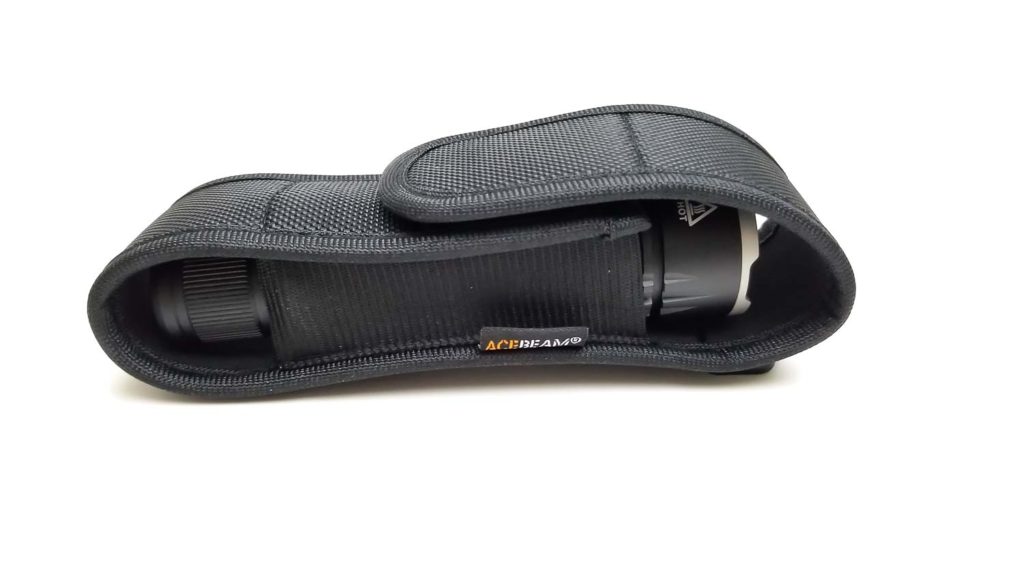
Build Quality, knurling, threads, and anodization
The fit and finish are top-notch, and Acebeam warranties the light 5 years (60 months) for workmanship and defects which is fantastic. The body is made from aerospace grade aluminum with type III hard anodizing and seems really tough. The finish had no flaws, blemishes, or bare spots anywhere. The machining is also flawless with no sharp edges, burrs, or machine marks. It’s a bit odd that there’s no knurling or texture on the body other than the battery cap which has ridges for gripping. Personally, I think that’s okay though since the size of the light, combined with the matte finish and tactical ring makes it easy to grip.
The tailcap has a thick gold-plated contact spring. It has dual o-rings, and the square cut threads are fully anodized with no defects. They were extremely smooth (and well-lubed). As far as disassembly, the pocket clip is detachable, and the anti-roll ring is removable. I would have liked to take the head and bezel off to take a peek at the LED and driver, but sadly it’s completely glued together. As previously mentioned, the battery tube is a double-walled configuration with two liners. The inside seems to have a finish of some sort, but not the same as the outside.
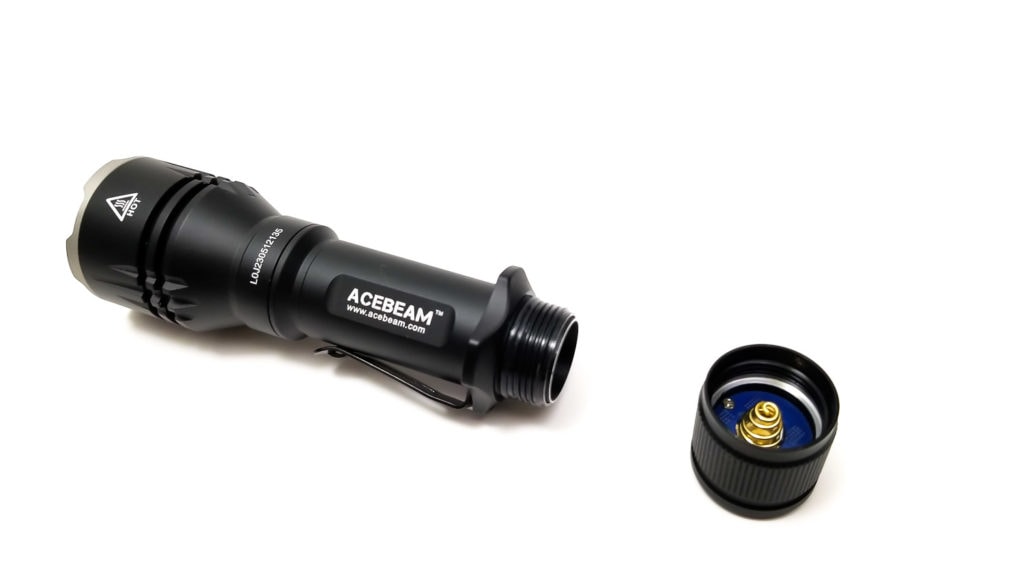
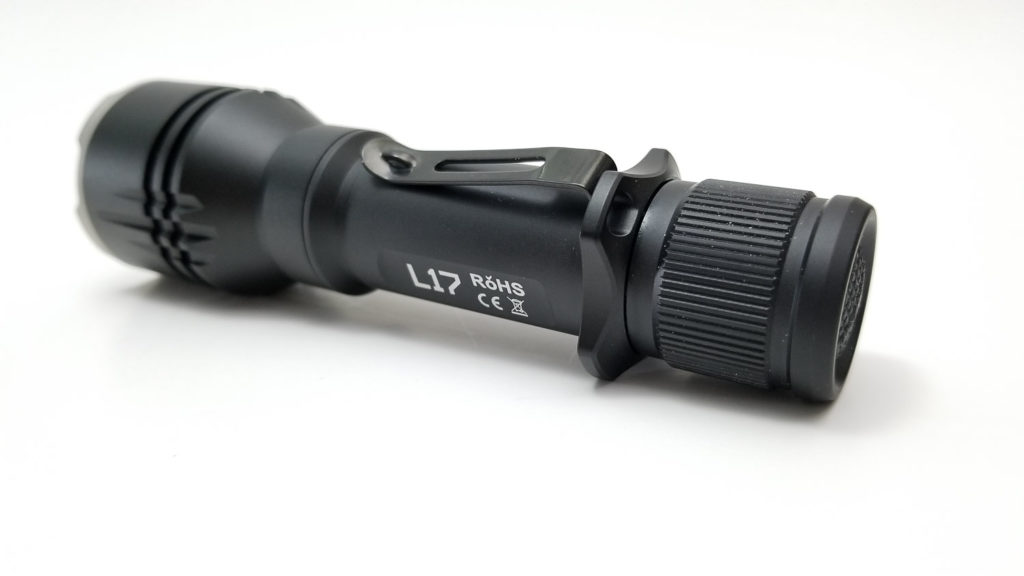
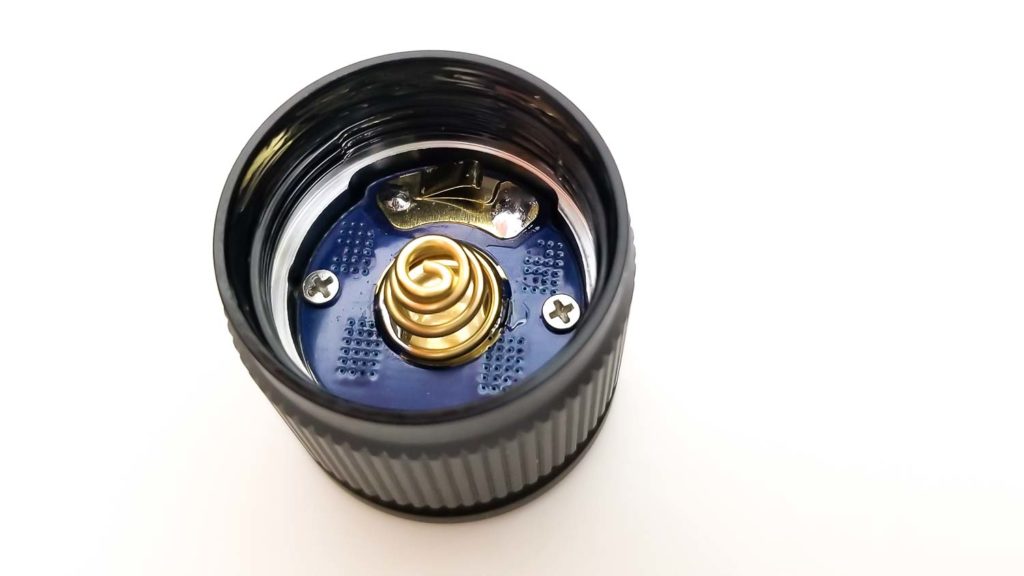
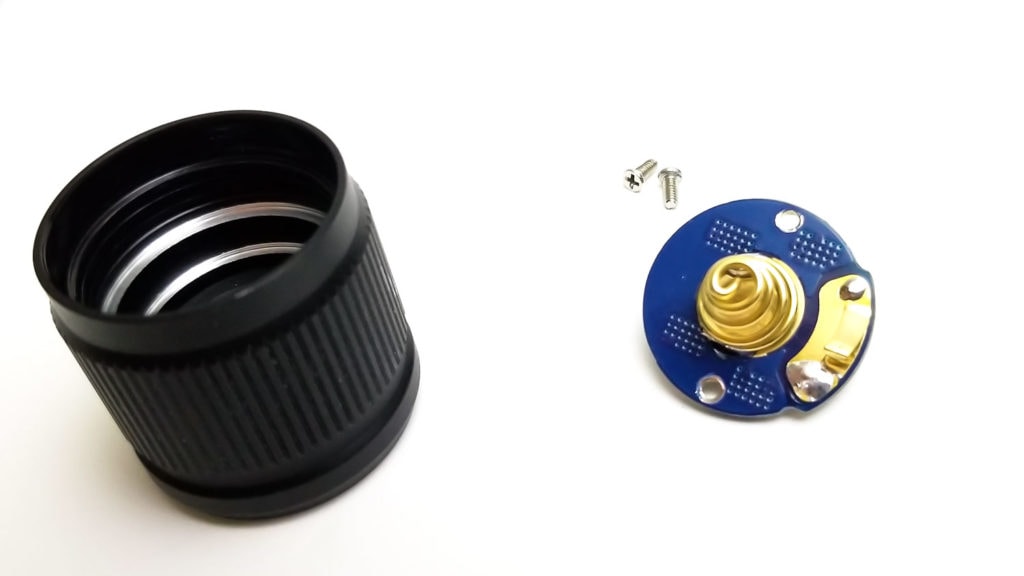
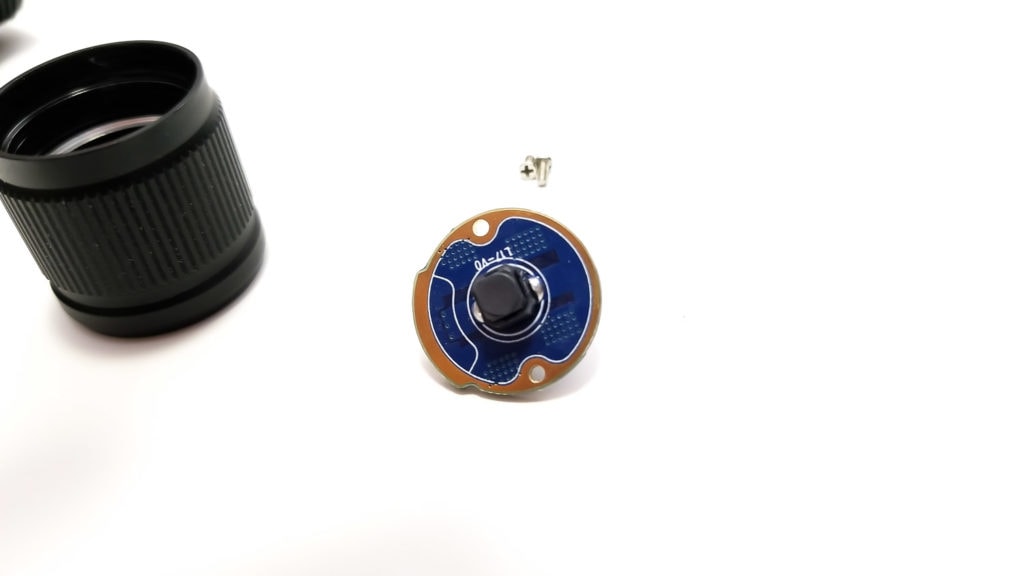
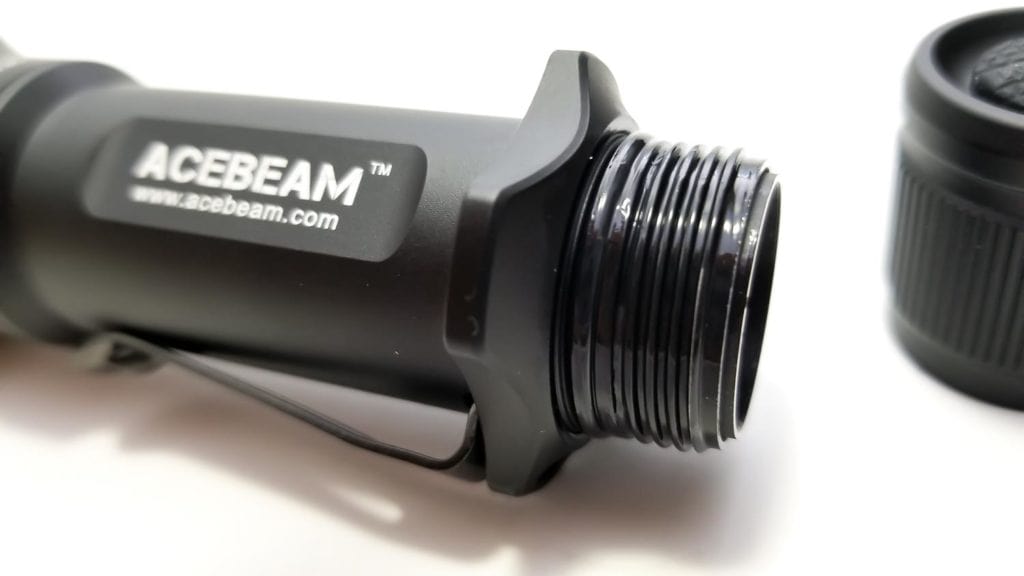
LEDs, Lens, Bezel, and Reflector
This is where the L17 gets interesting. Like the smaller Acebeam E10, the L17 uses a TIR (total internal reflection) optic which sits behind an AR-coated glass lens. The optic itself has a frosted center area over the LED, which may help soften the hotspot and add some spill. I did a side by side comparison on white carpet to check the beam pattern, and the beam was nearly all hotspot with very minimal spill. The C8 with an SST40 I compared it to has a much larger and more defined spill. Although there’s some side illumination, I found my reflector lights to be better for general purpose use.
The LED is made by OSRAM and comes in white, red, or green. The review sample came with the white version. Although Acebeam doesn’t give the specific model, based on the stated output, I strongly suspect it’s the KW CSLPM1.TG. This emitter is normally found in stage and effect lighting, and all those characters break down to indicate that this is a white, 3030-footprint LED with no dome. Enthusiasts know it as the white flat 2, and it’s naturally at home in a thrower. When focused in a reflector light, the beam produced is narrow and intense, like a laser beam. The color temperature looks to be around 5700k to 6000k, and although I like more neutral white emitters, I will say the beam looks good and the color is actually perfectly suited to this light.
The stainless bezel is really nicely machined and has a great-looking sandblasted finish that matches the anodizing. The crenulations on the bezel aren’t too aggressive, which I prefer, but would still do their job.
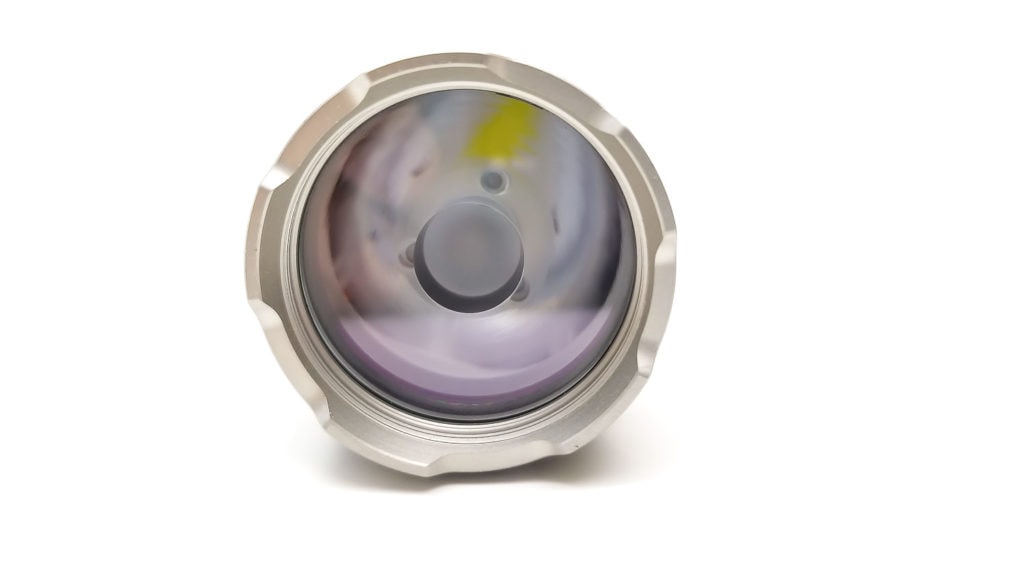
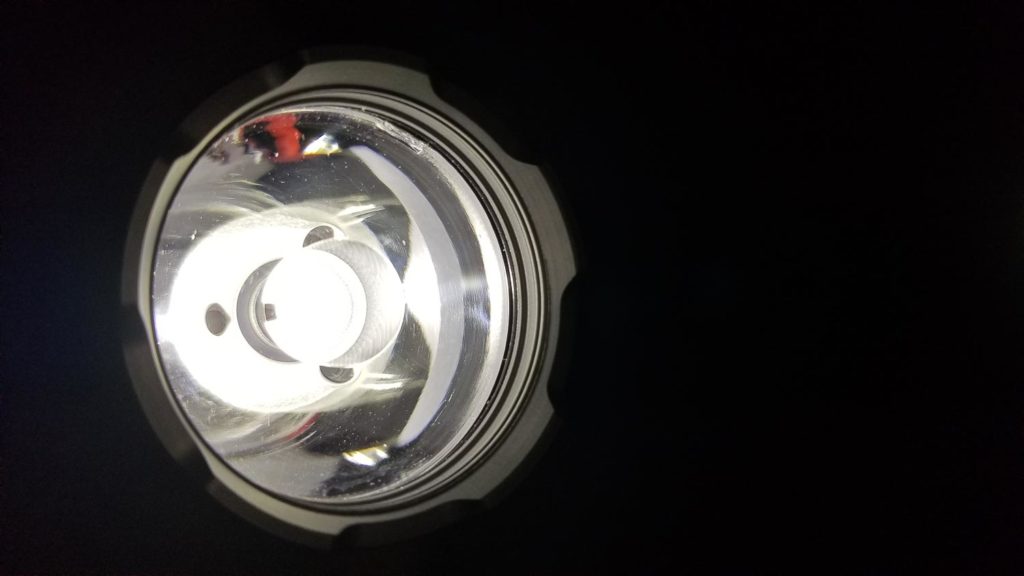
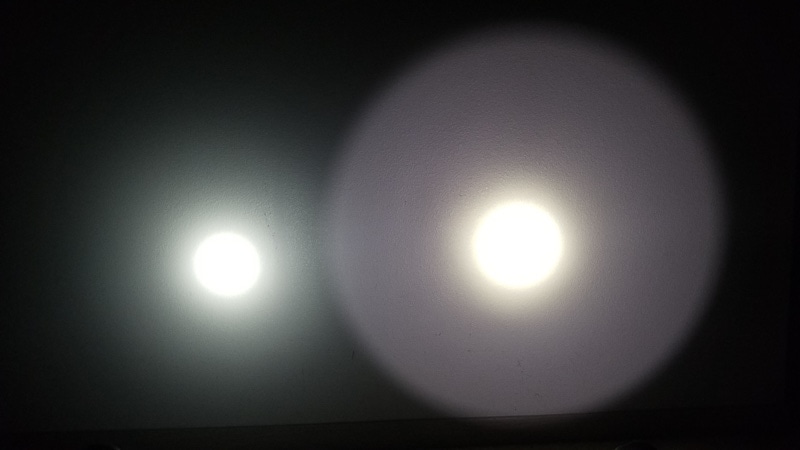
Dimensions:
- Length: 14.05 cm / 5.5 inches
- Head diameter: 4 cm / 1.5 inches
- Body diameter: 2.45 cm / 0.96 inches
Weight:
- Without cell 150 grams / 5.29 oz.
Size comparison
The L17 is pretty compact and I had no trouble carrying it in my pocket using the pocket clip.
Compared to other popular flashlights. From left to right: Acebeam L17, Acebeam L18, Acebeam L19.
Image 2: Skyray king, Acebeam L17, C8, Sofirn SP10s.
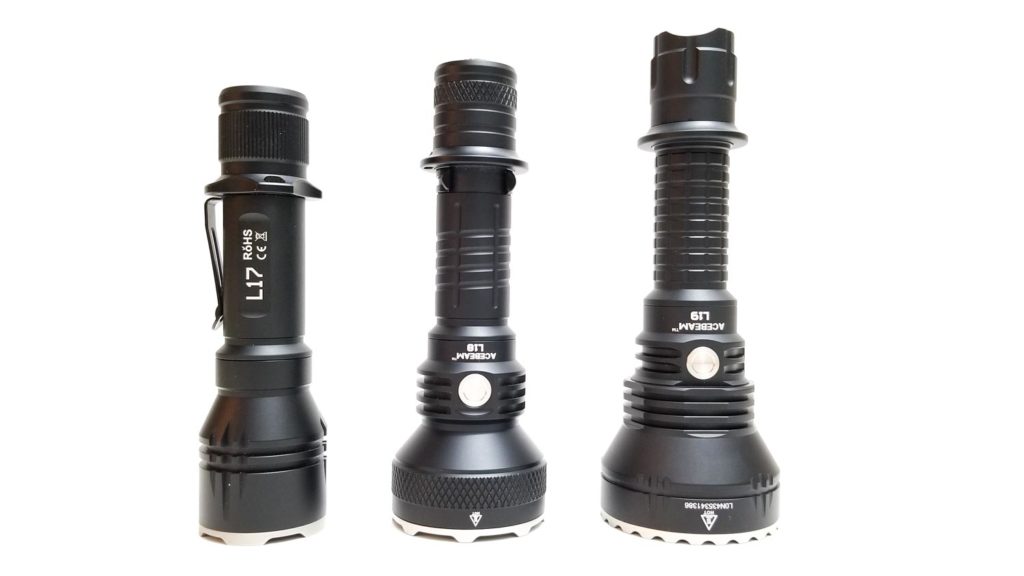
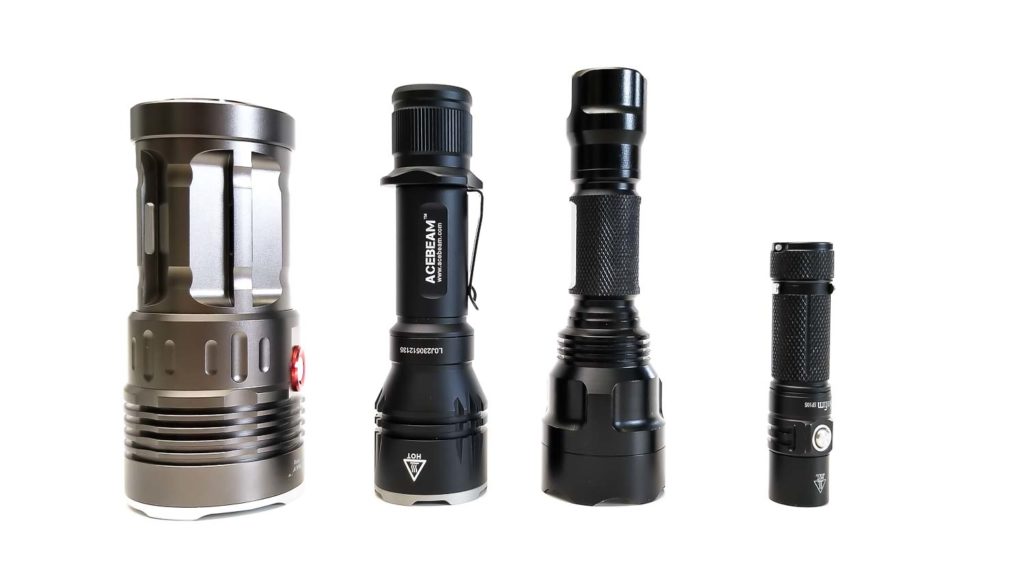
Driver & User Interface:
I really like the UI and was glad Acebeam kept it simple. The UI features ultra-low, low, medium, high, and turbo modes with a single strobe. It does have mode memory (ultra-low, and turbo are not memorized).
It’s a single click on, single click off. Press and hold from on and it steps between L-M-H then back to L. There is an electronic lockout, or you can lock the light by loosening the tailcap as well. The mode spacing is good in the lower modes, but turbo is a significant jump from 370 lm to 1400 lm. In my opinion, this isn’t a huge issue since you won’t really be using turbo up close like with an EDC or general purpose light.
Modes:
From OFF:
- Press and Hold: Pressing and holding for 3 seconds activates the ultra-low mode of 15 Lumens. Pressing and holding for 5 seconds activates or deactivates the electronic lockout.
- Single-click: Turns on in last mode memorized
- Double click: Turbo
- Triple-click: Strobe
- 4x click: Defaults to strobe
From ON:
- Press and Hold: Cycles between low-medium-high-low
- Single-click: Turns off
- Double click: Turbo
- Triple-click: Strobe
- 4 clicks: Defaults to strobe
Mode memory:
- Yes, last mode memory. You activate mode memory by selecting the mode you want and unscrewing the tail cap until the light turns off. Tighten the tailcap and the light will start in that mode when turned on.
Low voltage warning:
- Yes. Around 3.1 volts, the light will blink 3 times and drop to low mode.
Strobe/blinkies
- Yes, single strobe. You can activate it from on or off with 3 clicks.
Lock-out mode:
- Yes. Press and hold for 5 seconds from off and the light will flash 3 times to confirm the lock. To unlock, press and hold 5 seconds and the light turns on in ultra-low mode. I noticed there is no indicator (no blinks or anything) that the light is in lock mode.
PWM
- Acebeam claims it doesn’t have PWM, and I didn’t see any with the naked eye or cell phone camera.
Batteries and charging:
The Acebeam L17 uses 18650 lithium-ion batteries or two CR123A batteries. The kit I received came with a protected 3100 mAh Acebeam-branded button top 18650 battery with integrated Micro USB charging. The battery is sold by Acebeam as an optional accessory as well. I didn’t have any CR123A batteries on hand so I didn’t try those.
The included cell is 5 mm longer than a standard 18650, so I tried with an unprotected Vapcell VTC6 flat top to see if it fit, which it did. Unfortunately, the cell rattled around inside the battery tube so it wasn’t a very tight fit. At 70 mm long, the cell was too long and didn’t fit in my Thorfire C8.
The max charge rate on the battery is listed at 1 A. There’s a tiny LED on top near the positive terminal that glows (dimly) green when fully charged, and red when it needs to be recharged. With the battery down to 3.1 volts, it took about 3 hours to fully charge. Not exactly fast charging so it would have been nice to have a higher charge rate or USB type C for faster recharging.
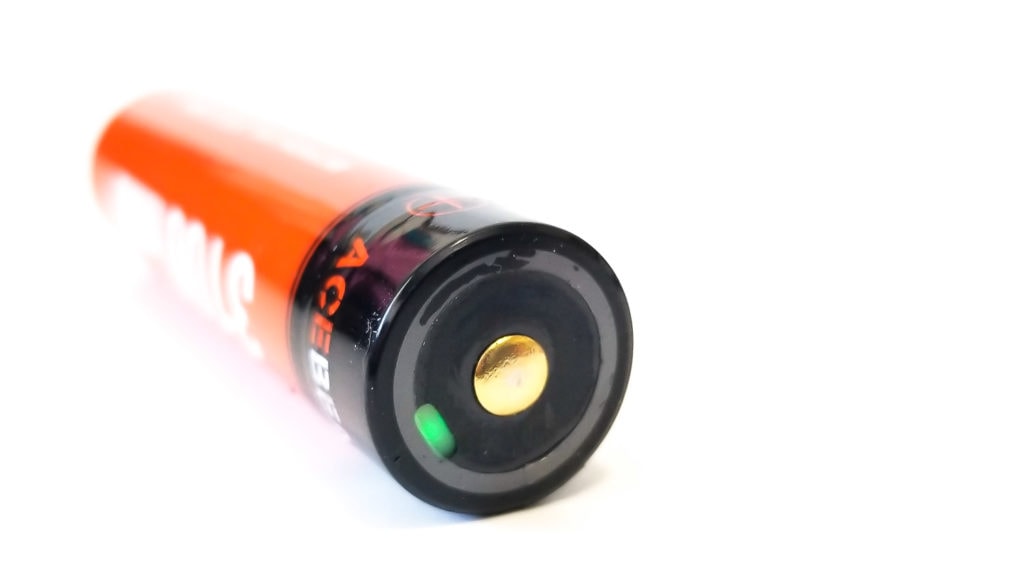
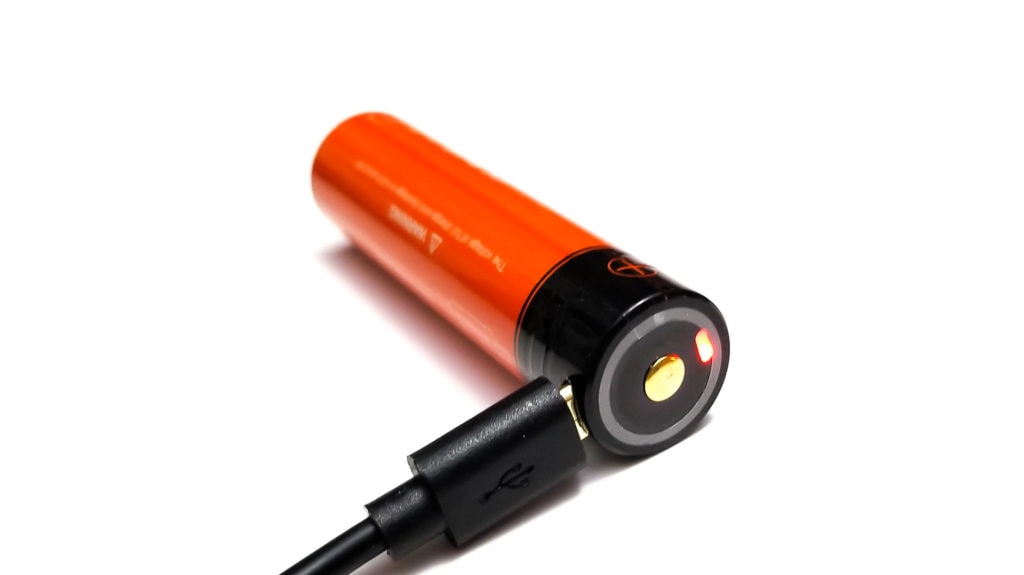
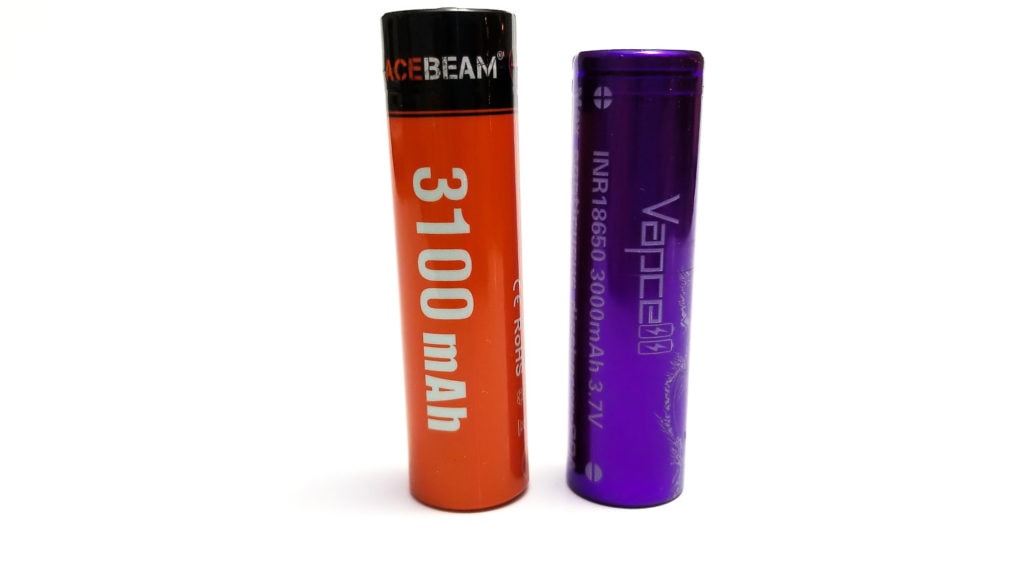
Performance:
To me, this was the most exciting part of the review since it’s really where we get to see how close (or how exaggerated) the manufacturer ratings are, especially since Acebeam claims this is “the world’s longest-throwing tactical light.”
For the amp measurement, I used my Radio Shack T-RMS multimeter with short 16 gauge wires inserted directly into the meter using the included (fully charged) battery. Measuring the current was tricky since the battery tube is double-walled and has two contact points. Only the lower contact point gave measurable readings.
Amp measurement
- Standby/parasitic draw: 0.16 mA
- Ultra-low: 6 mA
- Low: 27 mA
- Med: 325 mA
- High: 1 A
- Turbo: 6.63 A (measured at 5 seconds)
Runtime graph
Runtime was measured using my homemade 30 cm integrating sphere with Digi-Sense 20250-00 data-logging luxmeter. The sphere is calibrated against lights with known outputs including the Solarstorm SC01. Temperature measurements were taken using an Ames Instruments non-contact infrared thermometer. I used the included (fully-charged) battery.
I performed a turbo and high runtime test. The battery was fully recharged in between each test. The turbo mode test behaved predictably with it stepping down at around 3 minutes to what seems like high, which lasted for about an hour before stepping down to low mode. It ran for another 3 hours 42 minutes before the light shut off. I monitored the head temperature for the first hour and it never went over 63.5 C, but it did heat up fast, reaching 50 C in about 60 seconds.

Total runtime for turbo was 4 hours, 47 minutes. After the test, the cell voltage was 2.74 volts, which is a safe discharge voltage for lithium ion cells so the protection circuit did its job.
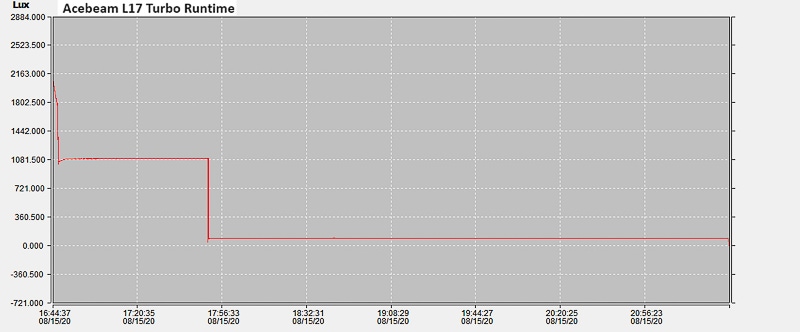
The high mode test shows the light running for over 2 hours on high until the low voltage warning.It steps down to the low mode and runs for another 3 hours before shutting off.
For a temperature regulated light, Acebeam did a good job with their temperature regulation as I didn’t see any rollercoaster behavior with the output, just minor fluctuations of +/- 2 or 3 lux.
Lumen measurements (for each mode)
Lumen measurements were taken using my homemade 30 cm integrating sphere and Digi-Sense 20250-00 data logging luxmeter. Readings taken at 30 seconds.
| Mode | Measured | Specs: |
|---|---|---|
| Ultra low | 14.85 lm | Acebeam: 15 lm |
| Low | 54 lm | 50 lm |
| Medium | 189 lm | 150 lm |
| High | 425 lm | 370 lm |
| Turbo | 1353.75 lm | 1400 lm |
Throw numbers:
This is where Acebeam makes the boldest claim: 802 meters for a flashlight without a reflector. Does it measure up? I tested the light outdoors at 10 meters. Acebeam’s numbers are in parentheses. All figures were recorded at 30 seconds.
| Mode (specified) | Measurement |
|---|---|
| Ultra-low (120m( | 940 cd = 61 m |
| Low (210m) | 4810 cd = 134 m |
| Medium (306m) | 15,770 cd = 251 m |
| High (410m) | 35,720 cd = 378 m |
| Turbo (802m) | 120,600 cd = 695 m |
I thought I had an issue with my luxmeter, so I tested again, and the numbers were correct. Although I didn’t match or beat Acebeam’s numbers, I think these are pretty remarkable figures for an optic light. I do want to add that at 5 seconds I measured 1282 lux for 128.2 kcd which is 716 m of throw. Close, but still not 802 m. However, looking at the beam in the dark, it seemed like it threw farther than the numbers suggest.
Here is the list with most of the single 18650 throwers we reviewed, reaching 500 meters or farther.
| Flashlight | Battery | Max. Output (lm) | @30sec (lm) | Candela (cd) | Distance (m) |
|---|---|---|---|---|---|
| Noctigon KR1 | Samsung 30Q | 1061 | – | 83500 | 578 |
| Convoy C8+ | Samsung 30Q | – | – | 83900 | 598 |
| Boruit C8 | Boruit 2200 | 441 | 435 | 120000 | 693 |
| Acebeam L17 | Acebeam ARC18650H-310A | 1354 | – | 120600 | 695 |
| Lumintop GT Mini | Samsung 25R | 1176 | – | 121000 | 695 |
| Microfire Falcon H8 | Samsung 30Q | 331 | 328 | 176000 | 839 |
| Weltool T11 | Panasonic 3400 | 571 | – | 255250 | 1010 |
| Nextorch T7L (LEP) | Nextorch 2600 | 524 | 524 | 437000 | 1322 |
| Speras TH2 | Speras 3400 | 305 | – | 588100 | 1534 |
Beamshots:
I compared the L17 with three lights. A C8 with a fet-driven SST40, C8 with a de domed XP-L, and a C8 with a fet-driven XHP50.2 3 volt. All had SMO reflectors. The L17 was easily the throwiest with an intense, narrow beam, followed by the SST40, then the XHP50.2. The trees are between 150 m and 200 m away. These lights all throw pretty far and make more lumens than the L17 (the XHP50.2 is making over 3100 lm), but the L17 out-throws them easily with the narrow intense beam. Nice!

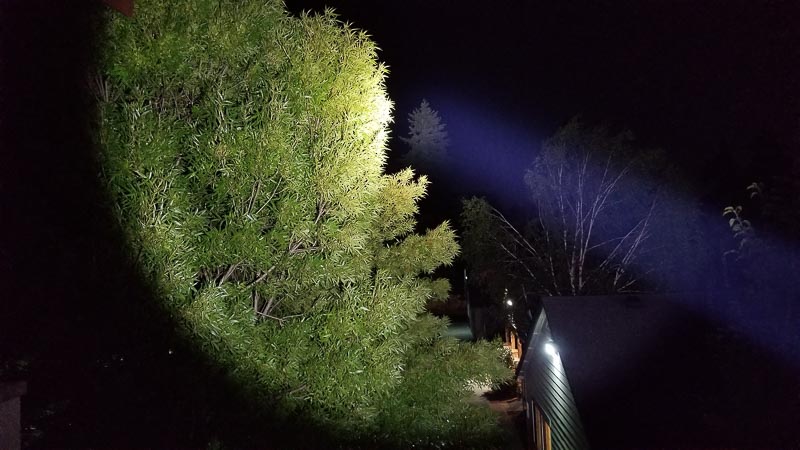
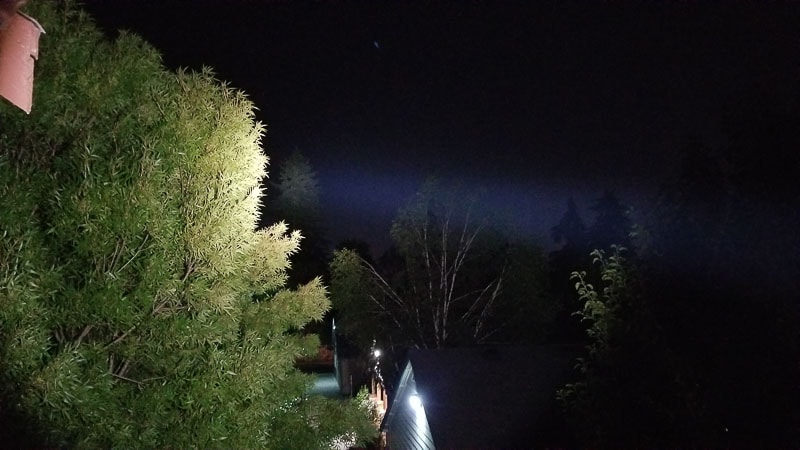
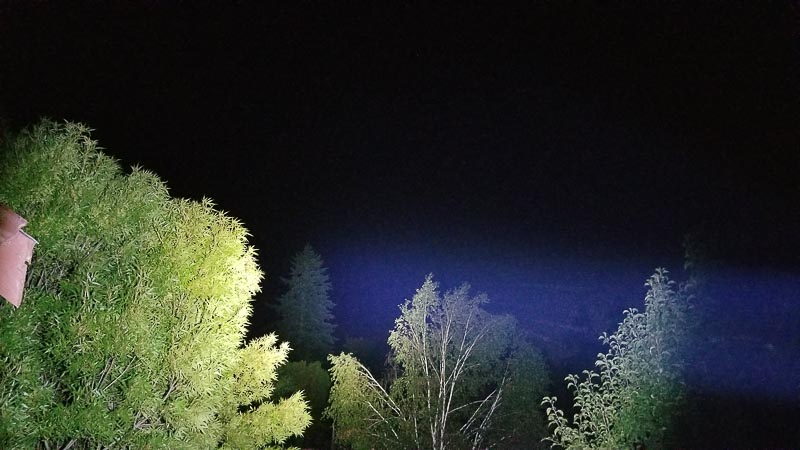
Disclaimer: This flashlight was sent to me for review at no cost, by Nitetorch. I have not been paid to review, nor have I been holding back on problems or defects.
Overall conclusion
Pros:
- Excellent build quality
- Includes lots of high quality accessories
- Great finish
- Simple UI
- Throws pretty far
Cons
- The switch!
- Gets hot fast on turbo
- Optimistic factory throw rating

Rating: 4 stars ★★★★
To be clear, this is a great, high quality flashlight. The build quality is excellent, as is the finish. I like that the kit came with everything needed to get up and running and really appreciated that Acebeam didn’t cheap out and include low-quality accessories like some manufacturers do. Acebeam did a good job with the UI as well. However, I found myself in the midst of a conundrum. Is this a thrower or a tactical light? I don’t see it as a true tactical light due to the switch being a reverse type, plus the beam profile has too much hotspot and not enough side illumination for general purpose use. That said, I think it’s more of a thrower than a tactical light.
Even if it doesn’t meet the factory numbers, it does throw pretty darn good, and like the smaller Acebeam E10 and Manker MC13, the L17 proves that you don’t need a reflector to project light long distances. I think the L17 is a nice option for someone wanting a really compact light that throws pretty far. Although I really like the L17, I just can’t look past the mushy switch, the fact it heats up so fast, and overly optimistic factory throw numbers, so I give it 4 stars.
Acebeam L17 for sale
Nitetorch is closed. Instead, look at all the other Acebeam flashlights for alternatives
1lumen selects and reviews products personally. We may earn affiliate commissions through our links, which help support our testing.
